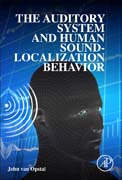
The Auditory System and Human Sound-Localization Behavior provides a comprehensive account of the full action-perception cycle underlying spatial hearing. It highlights the interesting properties of the auditory system, such as its organization in azimuth and elevation coordinates. Readers will appreciate that sound localization is inherently a neuro-computational process (it needs to process on implicit and independent acoustic cues). The localization problem of which sound location gave rise to a particular sensory acoustic input cannot be uniquely solved, and therefore requires some clever strategies to cope with everyday situations. The reader is guided through the full interdisciplinary repertoire of the natural sciences: not only neurobiology, but also physics and mathematics, and current theories on sensorimotor integration (e.g. Bayesian approaches to deal with uncertain information) and neural encoding. Quantitative, model-driven approaches to the full action-perception cycle of sound-localization behavior and eye-head gaze controlComprehensive introduction to acoustics, systems analysis, computational models, and neurophysiology of the auditory systemFull account of gaze-control paradigms that probe the acoustic action-perception cycle, including multisensory integration, auditory plasticity, and hearing impaired INDICE: 1. Introduction 2. The nature of sound 3. Linear systems analysis 4. Nonlinear systems analysis 5. The cochlea 6. The auditory nerve 7. Cues for human sound localization 8. Assessing auditory spatial performance 9. The gaze orienting system 10. The midbrain colliculus 11. Coordinate transformations in the brain 12. Sound localization behavior and plasticity 13. Audiovisual integration 14. The Auditory System and Human Sound-Localization Behavior
- ISBN: 978-0-12-801529-2
- Editorial: Academic Press
- Encuadernacion: Cartoné
- Páginas: 440
- Fecha Publicación: 01/04/2016
- Nº Volúmenes: 1
- Idioma: Inglés
